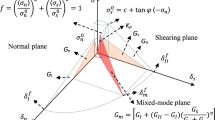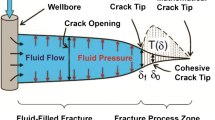Abstract
Hydraulic fracturing operation success is critically dependent on pre-operation fracture geometry analysis. Meantime, hydraulic fracture opening determination is crucial because it deals with maintaining sufficient aperture and efficient communication pathways to accomplish proppant placement and avoid screen-outs or proppant bridging. It is well understood that, to efficiently estimate the hydraulic fracture opening, a thorough understanding of the impact of rock mechanical properties as well as operational parameters such as injection fluid viscosity and leak-off are essential. In this study, a three-dimensional model has been developed for parametric study of fracture stiffness, formation elastic modulus, formation Poisson’s ratio, tensile strength of the rock, fracturing fluid viscosity and leak-off, and their influences on hydraulic fracture opening. Cohesive elements with traction–separation law have been applied to simulate the fracturing process in a fluid-solid coupling model. The maximum nominal stress criterion has been selected for initiation of damage in the cohesive elements. The results revealed that any change in influential rock mechanical properties as well as operational parameters would significantly lead to increasing or decreasing the hydraulic fracture opening. It was observed from the controllable HF parameters including fracturing fluid viscosity and leak-off, by increasing fracturing fluid viscosity from 10−3 to 10 Pa.s, fracture width has been moderately increased from 8.83 to 13.3 mm; on the other hand, by reducing leak-off coefficient as a polymer-dependent HF parameter from 5 × 10−9 to 5 × 10−11 m/kPa.s, fracture width has been gradually risen from 7.27 to 11.52 mm. In addition, all the uncontrollable rock mechanical parameters such as fracture stiffness, Young’s modulus, Poisson’s ratio, and tensile strength have steeply increased or decreased the hydraulic fracture opening and consequently, all of their analysis will be discussed in detail in this research. The results from this study can be applied to hydraulic fracturing jobs in different conditions of fracture stiffness, formation elastic modulus, formation Poisson’s ratio, tensile strength of the rock, fracturing fluid viscosity, and leak-off.






Similar content being viewed by others
References
ABAQUS (2011) ABAQUS documentation, Version 6.11–1
Barenblatt GI (1962) The mathematical theory of equilibrium of cracks in brittle fracture. Adv Appl Mech 7:55–129
Batchelor GK (1967) An introduction to fluid dynamics. Cambridge University Press, London 615 pp
Bowie OL (1964) Rectangular tensile sheet with symmetric edge cracks. J Appl Mech 31:208–212
Chen Z (2011) Finite element modeling of viscosity-dominated hydraulic fractures. J Pet Sci Eng 88–89:136–144
Chen ZR, Bunger AP, Zhang X, Jeffrey RG (2009) Cohesive zone finite element based modeling of hydraulic fractures. Acta Mech Solida Sin 22:443–452
Dahi-Taleghani A, Olson JE (2011) Numerical numerical modeling of multistranded-hydraulic-fracture propagation: accounting for the interaction between induced and natural fractures. SPE J 16:575–581
Daneshy AA (1973) On the design of vertical hydraulic fractures. J Pet Technol 25(1):83–97
Dugdale DS (1960) Yielding of steel sheets containing slits. Journal of Mechanics and Physics of Solids 8:100–104
Fisher MK, Warpinski NR (2012) Hydraulic-fracture-height growth: real data. SPE Production & Operations 27(01):8–19
Fjaer E (2008) Petroleum related rock mechanic. Elsevier Publication Books, Amsterdam 491 pp
Fossen H (2010) Structural geology. Cambridge University Press, UK
Franquet JA, Economides MJ (1999) Effect of stress and stress path on Young’s modulus and Poisson ratio of unconsolidated rocks: a new idea for hydraulic fracturing. SPE Latin American and Caribbean Petroleum Engineering Conference, Caracas 21–23 April
Geertsma J, de Klerk F (1969) A rapid method of predicting width and extent of hydraulically induced fractures. J Pet Technol 21:1571–1581
Gu H, Siebrits E (2008) Effect of formation modulus contrast on hydraulic fracture height containment. SPE Production & Operations 23(02):170–176
Huang R, Sukumar N, Prevost JH (2003) Modeling quasi-static crack growth with the extended finite element method part II: numerical applications. Int J Solids Struct 40:7539–7552
Keshavarzi R, Mohammadi S (2012) A new approach for numerical modeling of hydraulic fracture propagation in naturally fractured reservoirs. SPE/EAGE European Unconventional Resources Conference and Exhibition, Vienna 20-22 March
Li Q, Chen M, Zhou Y, Jin Y, Wang FP, Zhang R (2013) Rock mechanical properties of shale gas reservoir and their influences on hydraulic fracture. International Petroleum Technology Conference, Beijing 26–28 March
Nordgren RP (1972) Propagation of a vertical hydraulic fracture. SPE J 12(8):306–314
Peirce A, Detournay E (2008) An implicit level set method for modeling hydraulically driven fractures. Computer Methods in Applied Mechanical Engineering 197:2858–2885
Perkins TK, Kern LR (1961) Widths of hydraulic fractures. J Pet Technol 13(9):937–949
Saberhosseini SE, Keshavarzi R, Ahangari K (2014) A new geomechanical approach to investigate the role of in-situ stresses and pore pressure on hydraulic fracture pressure profile in vertical and horizontal oil wells. Geomechanics and Engineering 7(3):233–246
Sarris E, Papanastasiou P (2011) The influence of the cohesive process zone in hydraulic fracture modeling. Int J Fract 167:33–45
Settari A, Cleary MP (1984) 3-dimensional simulation of hydraulic fracturing. J Pet Technol 36:1177–1190
Spence DA, Sharp PW (1985) Self-similar solution for elastohydrodynamic cavity flow. Proceedings of the Royal society of London Series A 400:289–313
Tada H, Paris PC, Irwin GR (1973) The stress analysis of cracks handbook. Del Research Corporation, Hellertown
Todd BL, Choudhary YK, Bhamidipati S (2011) Fracture-width estimation for an arbitrary pressure distribution in porous media. Brasil Offshore Conference and Exhibition, Macaé 14–17 June
Tomar V, Zhai J, Zhou M (2004) Bounds for element size in a variable stiffness cohesive finite element model. International Journal of Numerical Methods Engineering 61:1894–1920
Valco P, Economides MJ (1997) Hydraulic fracture mechanics. Texas A & M University, College Station Copy right at 1997 by John Wiley & Sons Ltd, 296 pp
Zhang GM, Liu H, Zhang J, Wu HA, Wang XX (2010) Three-dimensional finite element simulation and parametric study for horizontal well hydraulic fracture. J Pet Sci Eng 72:310–317
Zoback MD (2007) Reservoir Geomechanics. Cambridge University Press, London
Acknowledgments
The authors would like to thank Fatemeh Ataiyan for her special attempts on properly preparing the illustrative pictures of hydraulic fracturing process, the tables and graphs of this research.
Author information
Authors and Affiliations
Corresponding author
Rights and permissions
About this article
Cite this article
Saberhosseini, S.E., Keshavarzi, R. & Ahangari, K. A fully coupled three-dimensional hydraulic fracture model to investigate the impact of formation rock mechanical properties and operational parameters on hydraulic fracture opening using cohesive elements method. Arab J Geosci 10, 157 (2017). https://doi.org/10.1007/s12517-017-2939-7
Received:
Accepted:
Published:
DOI: https://doi.org/10.1007/s12517-017-2939-7




